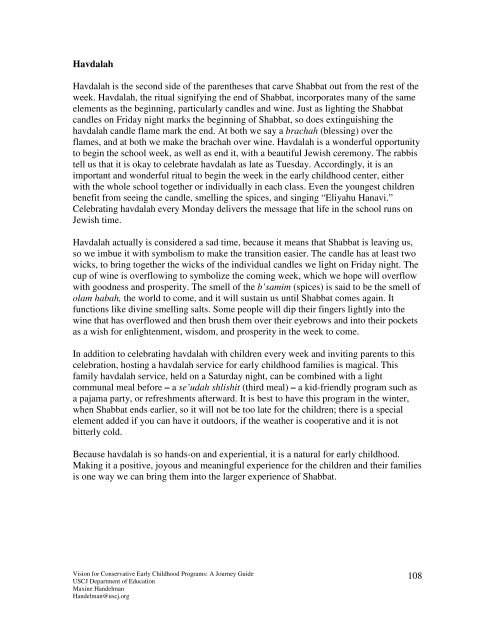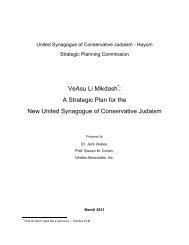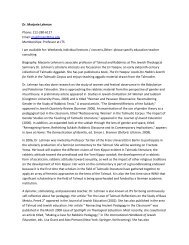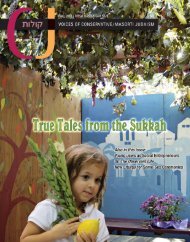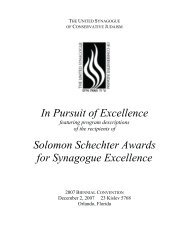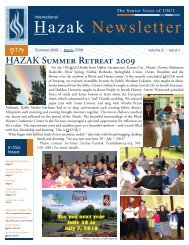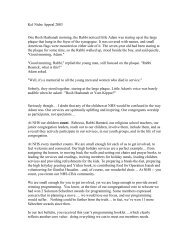Vision for Conservative Early Childhood Programs: A Journey Guide
Vision for Conservative Early Childhood Programs: A Journey Guide
Vision for Conservative Early Childhood Programs: A Journey Guide
Create successful ePaper yourself
Turn your PDF publications into a flip-book with our unique Google optimized e-Paper software.
Havdalah<br />
Havdalah is the second side of the parentheses that carve Shabbat out from the rest of the<br />
week. Havdalah, the ritual signifying the end of Shabbat, incorporates many of the same<br />
elements as the beginning, particularly candles and wine. Just as lighting the Shabbat<br />
candles on Friday night marks the beginning of Shabbat, so does extinguishing the<br />
havdalah candle flame mark the end. At both we say a brachah (blessing) over the<br />
flames, and at both we make the brachah over wine. Havdalah is a wonderful opportunity<br />
to begin the school week, as well as end it, with a beautiful Jewish ceremony. The rabbis<br />
tell us that it is okay to celebrate havdalah as late as Tuesday. Accordingly, it is an<br />
important and wonderful ritual to begin the week in the early childhood center, either<br />
with the whole school together or individually in each class. Even the youngest children<br />
benefit from seeing the candle, smelling the spices, and singing “Eliyahu Hanavi.”<br />
Celebrating havdalah every Monday delivers the message that life in the school runs on<br />
Jewish time.<br />
Havdalah actually is considered a sad time, because it means that Shabbat is leaving us,<br />
so we imbue it with symbolism to make the transition easier. The candle has at least two<br />
wicks, to bring together the wicks of the individual candles we light on Friday night. The<br />
cup of wine is overflowing to symbolize the coming week, which we hope will overflow<br />
with goodness and prosperity. The smell of the b’samim (spices) is said to be the smell of<br />
olam habah, the world to come, and it will sustain us until Shabbat comes again. It<br />
functions like divine smelling salts. Some people will dip their fingers lightly into the<br />
wine that has overflowed and then brush them over their eyebrows and into their pockets<br />
as a wish <strong>for</strong> enlightenment, wisdom, and prosperity in the week to come.<br />
In addition to celebrating havdalah with children every week and inviting parents to this<br />
celebration, hosting a havdalah service <strong>for</strong> early childhood families is magical. This<br />
family havdalah service, held on a Saturday night, can be combined with a light<br />
communal meal be<strong>for</strong>e – a se’udah shlishit (third meal) – a kid-friendly program such as<br />
a pajama party, or refreshments afterward. It is best to have this program in the winter,<br />
when Shabbat ends earlier, so it will not be too late <strong>for</strong> the children; there is a special<br />
element added if you can have it outdoors, if the weather is cooperative and it is not<br />
bitterly cold.<br />
Because havdalah is so hands-on and experiential, it is a natural <strong>for</strong> early childhood.<br />
Making it a positive, joyous and meaningful experience <strong>for</strong> the children and their families<br />
is one way we can bring them into the larger experience of Shabbat.<br />
<strong>Vision</strong> <strong>for</strong> <strong>Conservative</strong> <strong>Early</strong> <strong>Childhood</strong> <strong>Programs</strong>: A <strong>Journey</strong> <strong>Guide</strong><br />
USCJ Department of Education<br />
Maxine Handelman<br />
Handelman@uscj.org<br />
108


